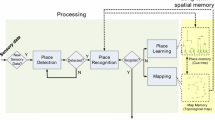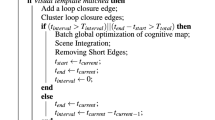Abstract
Determining one’s position within the environment is a basic feature of spatial behavior and spatial cognition. This task is of inherently sensorimotor nature in that it results from a combination of sensory features and motor actions, where the latter comprise exploratory movements to different positions in the environment. Biological agents achieve this in a robust and effortless fashion, which prompted us to investigate a bio-inspired architecture to study the localization process of an artificial agent which operates in virtual spatial environments. The spatial representation in this architecture is based on sensorimotor features that comprise sensory sensory features as well as motor actions. It is hierarchically organized and its structure can be learned in an unsupervised fashion by an appropriate clustering rule. In addition, the architecture has a temporal belief update mechanism which explicitly utilizes the statistical correlations of actions and locations. The architecture is hybrid in integrating bottom-up processing of sensorimotor features with top-down reasoning which is able to select optimal motor actions based on the principle of maximum information gain. The architecture operates on two sensorimotor levels, a macro-level, which controls the movements of the agent in space, and on a micro-level, which controls its eye movements. As a result, the virtual mobile agent is able to localize itself within an environment using a minimum number of exploratory actions.
Access this chapter
Tax calculation will be finalised at checkout
Purchases are for personal use only
Preview
Unable to display preview. Download preview PDF.
Similar content being viewed by others
References
Aloimonos, Y. (ed.): Special Issue: Purposive, Qualitative and Active Vision, Image Understanding, vol. 56 (1992)
Ballard, D.: Animate vision. Artificial Intelligence 48, 57–86 (1991)
Byun, Y.T., Kuipers, B.: A robot exploration and mapping strategy based on a semantic hierarchy of spatial representations. IEEE Journal of Robotics and Autonomous Systems 8, 47–63 (1991)
Delmotte, F., Smets, P.: Target identification based on the transferable belief model interpretation of Dempster-Shafer model. IEEE Transactions on Systems, Man, and Cybernetics, Part A: Systems and Humans 34(4), 457–471 (2004)
Dubois, D., Prade, H.: On the unicity of Dempster’s rule of combination. International Journal of Intelligent Systems 1(2), 133–142 (1986)
Elfes, A.: Sonar-based real-world mapping and navigation. IEEE Journal of robotics and automation 3(3), 249–265 (1987)
Foo, P., Warren, W.H., Duchon, A., Tarr, M.J.: Do humans integrate routes into a cognitive map? map- versus landmark-based navigation of novel shortcuts. Journal of Experimental Psychology 31(2), 195–215 (2005)
Frank, L., Brown, E., Wilson, M.: Trajectory encoding in the hippocampus and entorhinal cortex. Neuron 27(1), 169–178 (2000)
Gadzicki, K.: Hierarchical clustering of sensorimotor features. In: Mertsching, B., Hund, M., Aziz, Z. (eds.) KI 2009. LNCS (LNAI), vol. 5803, pp. 331–338. Springer, Heidelberg (2009)
Gibson, J.J.: The ecological approach to visual perception. Houghton Mifflin, Boston (1979)
Gillner, S., Mallot, H.A.: Navigation and acquisition of spatial knowledge in a virtual maze. Journal of Cognitive Neuroscience 10(4), 445–463 (1998)
Gordon, J., Shortliffe, E.H.: A method for managing evidential reasoning in a hierarchical hypothesis space. Artif. Intell. 26(3), 323–357 (1985)
Hirtle, S.C., Jonides, J.: Evidence of hierarchies in cognitive maps. Memory and Cognition 13(3), 208–217 (1985)
Hommel, B., Muesseler, J., Aschersleben, G., Prinz, W.: The theory of event coding (tec): A framework for perception and action planning. Behavioral and Brain Sciences 24, 849–878 (2001)
Kalman, R.: A new approach to linear filtering and prediction problems. Journal of Basic Engineering 82(1), 35–45 (1960)
Kohonen, T.: Self-organizing maps. Springer series in information sciences, 3rd edn., vol. 30. Springer, Heidelberg (2001)
Kuipers, B.: The map in the head metaphor. Environment and Behavior 14(2), 202–220 (1982)
Kuipers, B.: The spatial semantic hierarchy. Artificial Intelligence 119, 191–233 (2000)
Mataric, M.: Integration of representation into goal-driven behavior-basedrobots. IEEE Transactions on Robotics and Automation 8(3), 304–312 (1992)
Moore, T.: Shape representations and visual guidance of saccadic eye movements. Science 285(5435), 1914 (1999)
Nene, S., Nayar, S., Murase, H.: Columbia object image library (COIL-20). Tech. rep., Dept. Comput. Sci., Columbia Univ., New York (1996)
O’Keefe, J., Nadel, L.: The hippocampus as a cognitive map. Clarendon Press, Oxford (1978)
O’Regan, J.K., Noë, A.: A sensorimotor account of vision and visual consciousness. Behavioral and Brain Sciences 24, 939–973 (2001)
Orponen, P.: Dempster’s rule of combination is #P-complete. Artificial Intelligence 44(1-2), 245–253 (1990)
Pal, N., Bezdek, J., Hemasinha, R.: Uncertainty measures for evidential reasoning II: A new measure of total uncertainty. International Journal of Approximate Reasoning 8(1), 1–16 (1993)
Prinz, W.: A common coding approach to perception and action, relationships between perception and action: current approaches edn., pp. 167–203. Springer, Berlin (1990)
Reineking, T.: Particle filtering in the Dempster-Shafer theory. International Journal of Approximate Reasoning (2010) (in revision) (submitted) (Febuary 17, 2009)
Reineking, T., Kohlhagen, C., Zetzsche, C.: Efficient wayfinding in hierarchically regionalized spatial environments. In: Freksa, C. (ed.) Spatial Cognition VI. LNCS (LNAI), vol. 5248, pp. 56–70. Springer, Heidelberg (2008)
Reineking, T., Schult, N., Hois, J.: Combining statistical and symbolic reasoning for active scene categorization. In: Knowledge Discovery, Knowledge Engineering and Knowledge Management, IC3K 2009, Revised Selected Papers. Communications in Computer and Information Science. Springer, Heidelberg (2010) (in press)
Rizzolatti, G., Craighero, L.: The mirror-neuron system 27, 169–192 (2004)
Rizzolatti, G., Matelli, M.: Two different streams form the dorsal visual system: anatomy and functions. Experimental Brain Research 153(2), 146–157 (2003)
Salton, G.: The SMART Retrieval System—Experiments in Automatic Document Processing. Prentice-Hall, Inc., Upper Saddle River (1971)
Schill, K.: Decision Support Systems with Adaptive Reasoning Strategies. In: Freksa, C., Jantzen, M., Valk, R. (eds.) Foundations of Computer Science. LNCS, vol. 1337, pp. 417–427. Springer, Heidelberg (1997)
Schill, K., Umkehrer, E., Beinlich, S., Krieger, G., Zetzsche, C.: Scene analysis with saccadic eye movements: Top-down and bottom-up modeling. Journal of Electronic Imaging 10(1), 152–160 (2001)
Schill, K., Zetzsche, C., Hois, J.: A belief-based architecture for scene analysis: From sensorimotor features to knowledge and ontology. Fuzzy Sets and Systems 160(10), 1507–1516 (2009)
Shafer, G.: A Mathematical Theory of Evidence. Princeton University Press, Princeton (1976)
Siegel, A., White, S.: The development of spatial representations of large-scale environments. Advances in child development and behavior 10, 9 (1975)
Smets, P.: Belief functions: The disjunctive rule of combination and the generalized Bayesian theorem. International Journal of Approximate Reasoning 9, 1–35 (1993)
Tanimoto, T.: IBM interal report. Tech. rep., IBM (November 1957)
Thrun, S., Fox, D., Burgard, W., Dellaert, F.: Robust Monte Carlo localization for mobile robots. Artificial Intelligence 128(1-2), 99–141 (2001)
Thrun, S.: Learning occupancy grids with forward sensor models. Autonomous Robots 15, 111–127 (2003)
Tversky, B.: Distortions in cognitive maps. Geoforum 23(2), 131–138 (1992)
Wang, R.F., Spelke, E.S.: Updating egocentric representations in human navigation. Cognition 77, 215–250 (2000)
Ward, J.H.: Hierarchical grouping to optimize an objective function. Journal of the American Statistical Association 58(301), 236–244 (1963)
Wiener, J., Mallot, H.: ’Fine-to-coarse’ route planning and navigation in regionalized environments. Spatial Cognition and Computation 3(4), 331–358 (2003)
Wiener, J., Mallot, H.: ’Fine-to-coarse’ route planning and navigation in regionalized environments. Spatial Cognition and Computation 3(4), 331–358 (2003)
Yarbus, A.L.: Eye Movements and Vision. Plenum Press, New York (1967)
Zetzsche, C., Galbraith, C., Wolter, J., Schill, K.: Navigation based on a sensorimotor representation: a virtual reality study. In: Rogowitz, B.E., Pappas, T.N., Daly, S.J. (eds.) Proceedings of SPIE. Human Vision and Electronic Imaging XII, February 2007, vol. 6492 (2007)
Zetzsche, C., Krieger, G.: Nonlinear operators and higher-order statistics in image processing and analysis. In: Proc. ISPA 2001 - 2nd International Symposium on Image and Signal Processing and Analysis, pp. 119–124 (2001)
Zetzsche, C., Wolter, J., Galbraith, C., Schill, K.: Representation of space: image-like or sensorimotor. Spatial Vision 22(5), 409–424 (2009)
Zetzsche, C., Wolter, J., Schill, K.: Sensorimotor representation and knowledge-based reasoning for spatial exploration and localisation. Cognitive Processing 9, 283–297 (2008)
Author information
Authors and Affiliations
Editor information
Editors and Affiliations
Rights and permissions
Copyright information
© 2010 Springer-Verlag Berlin Heidelberg
About this paper
Cite this paper
Reineking, T., Wolter, J., Gadzicki, K., Zetzsche, C. (2010). Bio-inspired Architecture for Active Sensorimotor Localization. In: Hölscher, C., Shipley, T.F., Olivetti Belardinelli, M., Bateman, J.A., Newcombe, N.S. (eds) Spatial Cognition VII. Spatial Cognition 2010. Lecture Notes in Computer Science(), vol 6222. Springer, Berlin, Heidelberg. https://doi.org/10.1007/978-3-642-14749-4_16
Download citation
DOI: https://doi.org/10.1007/978-3-642-14749-4_16
Publisher Name: Springer, Berlin, Heidelberg
Print ISBN: 978-3-642-14748-7
Online ISBN: 978-3-642-14749-4
eBook Packages: Computer ScienceComputer Science (R0)




